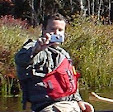 |
| East Jetty at the Harbor of Refuge |
After a few days of paddling in Point Judith Pond, I decided to head over to Camp Cronin to paddle the Harbor of Refuge. The tide was low but coming in, and the wind was from the north blowing across the harbor.
Despite the construction of the Point Judith Light (c. 1810/1857), conditions remained treacherous around Point Judith, and a Federal project was initiated to construct over 3-miles of jetties to provide a secure breakwater refuge for shipping. Work began in 1890 with construction of the east (3,640 feet) and west (2,240 feet) jetties, and was completed in 1910 with construction the V-shaped center jetty (6,970 feet). A 1,500 foot opening was left for the east passage, and a 1,200 foot opening was left for the west passage.
 |
| Breakwater to the Harbor of Refuge |
Then, in the 1930's, the State of Rhode Island dredged an anchorage basin just inside the Breachway and built wharves to create a port for large, ocean-going fishing vessels. This allowed the Galilee to become one of the largest fishing ports on the east coast
 |
| Breaks in the rocks on the East Jetty |
There were surprisingly few fishermen on the east jetty as I headed out. The sea was relatively calm behind the breakwater with small wind-blown waves, but I crossed the east passage in 1-2 foot rolling waves – always the most stressful part of the trip.
 |
| Waves breaking on the East Jetty |
It was easy to paddle down the west jetty into the wind, but a little more difficult paddling in the crosswind across the beach back to Camp Cronin.
 |
| Taking a break on the sandbar a mile from shore |
Links:



No comments:
Post a Comment
Note: Only a member of this blog may post a comment.